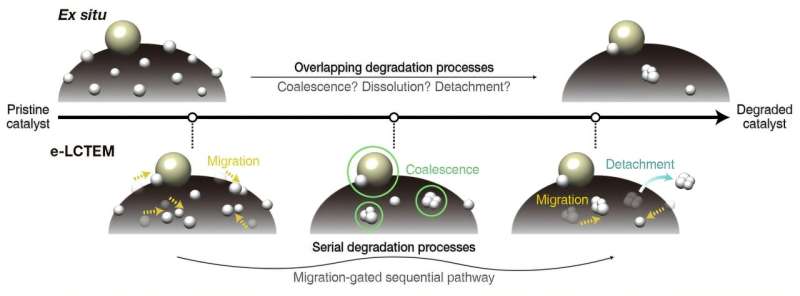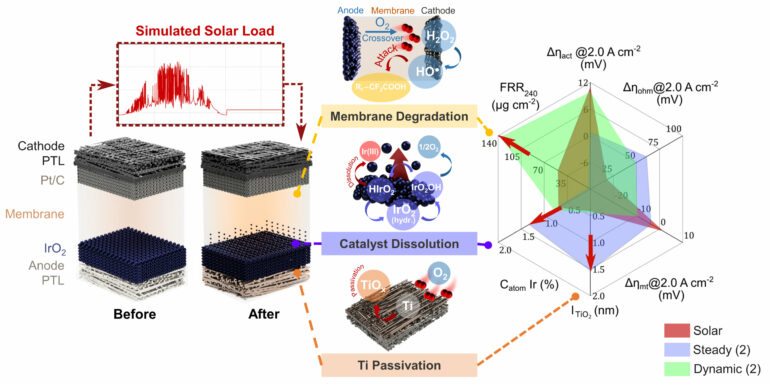Researchers at the College of Engineering at Seoul National University have developed an innovative technology for rapid durability assessment and identification of degradation mechanisms of hydrogen fuel cell catalysts.
The research is published in the Journal of the American Chemical Society.
Proton-exchange membrane fuel cells (PEMFCs), which generate electricity from hydrogen while emitting only pure water as a byproduct, are gaining attention as a clean energy technology that can replace fossil fuels. With high energy density and rapid refueling capabilities, hydrogen fuel cells are considered as a next-generation technology that can address existing limitations of conventional electric vehicles, particularly driving range and charging time.
However, fuel cell catalysts, which are crucial materials for promoting electricity generation reactions, generally undergo structural damage or catalyst loss during operation, leading to a gradual decline in their performance. This catalyst degradation is a major obstacle to the commercialization of fuel cells, as it reduces the lifetime and reliability of the cell, making the system less economical and increasing shipping costs.

(Top) Limitations of traditional fuel cell catalyst degradation analysis methods. Overlapping degradation processes are captured, making it difficult to identify which degradation process is the major cause. (Lower) The new analysis method developed by the research team. The time-resolved degradation processes can be monitored, allowing for decoupling of the overlapping processes and the major cause can be identified. © Journal of the American Chemical Society (2024). DOI: 10.1021/jacs.4c08825
Therefore, identifying the fundamental causes of degradation is critical to enhancing catalyst durability and enabling the stable, long-term operation of fuel cells. However, observing the structural changes of catalysts at nanometer-scale in the liquid electrolyte environment during electrochemical reactions of an operating fuel cell has posed a formidable technical challenge.
To address this, the joint research team developed an innovative analysis technique called electrochemical liquid-cell transmission electron microscopy (e-LCTEM). This technique, which monitors the time-resolved continuous degradation process of catalysts in high resolution, enables rapid evaluation of fuel cell catalyst degradation.
It significantly accelerates durability testing of hydrogen fuel cell vehicles, reducing what traditionally required tens of thousands of kilometers of driving to a process that can be completed within hours. This paves the way for more efficient catalyst durability verification at nanometer-scale precision, while dramatically reducing evaluation costs.

A schematic illustration of the structure-based differences in catalyst stability revealed by the research team. © Journal of the American Chemical Society (2024). DOI: 10.1021/jacs.4c08825
The representative catalyst of fuel cells, “platinum nanoparticle-carbon support hybrid catalyst (Pt/C),” has a structure in which platinum nanoparticles are evenly distributed on the carbon support. This structure, which maximizes the surface area of platinum particles, offers the advantage of reducing the amount of costly platinum while maintaining the high activity of platinum and securing high conductivity through carbon support.
However, the catalyst exhibits a complex degradation mechanism that involves simultaneous dissolution, migration, coalescence, and detachment of platinum particles and corrosion of the carbon support during long-term operation of a fuel cell. These structural changes in catalysts and resulting performance degradation are a significant barrier to the commercialization of fuel cells, but the mechanism has not been clearly understood.
The research team tackled this challenge using a newly developed “e-LCTEM” analysis technique. This method enables time-resolved monitoring of the continuous degradation process of platinum-carbon (Pt/C) catalysts with high resolution under an electrified environment during cell running.
Unlike previous studies, which were limited to simple comparison of the catalyst structure before and after fuel cell operation, this study provides a distinctive approach by enabling real-time observation of structural changes under cell operating conditions, thus revealing the precise continuous degradation mechanism.
As a result, the research team reveals that while small platinum nanoparticles exhibit high mobility that leads to coalescence with surrounding particles or detachment from the carbon support, larger particles show low mobility and high structural stability.
This suggests that the size of the particles has an important influence on the degradation mechanism. Meanwhile, the degradation process of coalesced particles was also observed for the first time, and it was confirmed that these coalesced particles also exhibit high mobility and eventually detach from the support despite their enlarged sizes.
Professor Jungwon Park, who supervised the research, emphasized, “This significant study opens the path for rapid and accurate evaluation of the durability of fuel cell catalysts and sheds new light on the major cause of catalyst degradation.”
Professor Jaeyune Ryu, who co-supervised the research, stated, “Through this study, which precisely reveals the underlying causes of catalyst degradation and provides guidance for improvement in its performance, we look forward to the development of more stable and efficient high-performance hydrogen fuel cell systems.
“Furthermore, we expect this achievement will contribute to accelerating the transition toward a sustainable, environmentally sustainable energy society.”
More information:
Sungin Kim et al, Unraveling Serial Degradation Pathways of Supported Catalysts through Reliable Electrochemical Liquid-Cell TEM Analysis, Journal of the American Chemical Society (2024). DOI: 10.1021/jacs.4c08825
Provided by
Seoul National University
Citation:
New technique enables rapid evaluation of fuel cell catalyst durability, identification of degradation mechanisms (2025, January 13)



